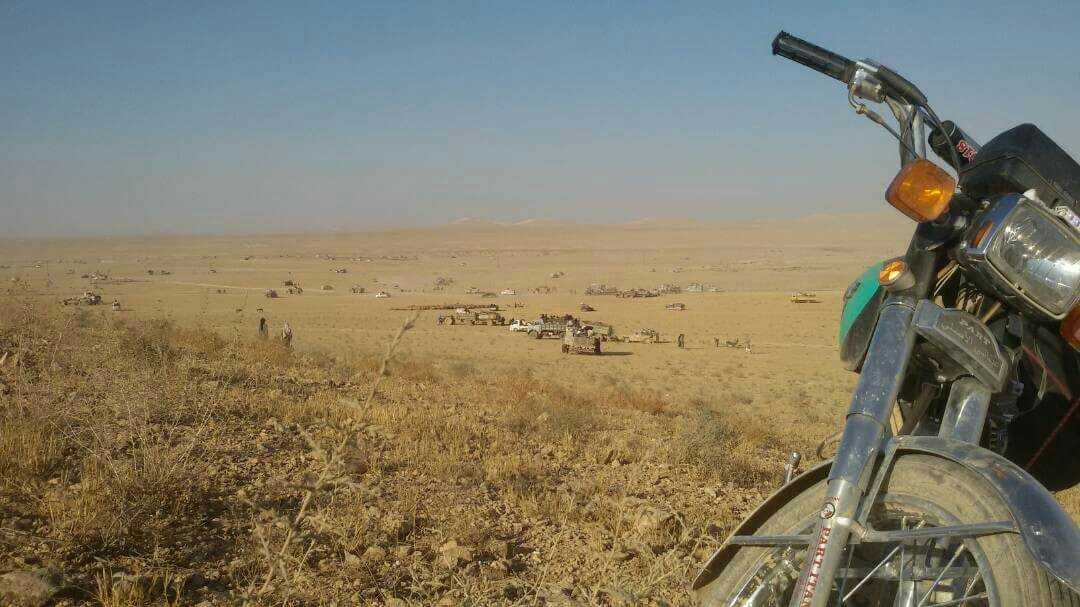Thousands of displaced Syrians ‘exposed to the elements’ in desert awaiting evacuation from embattled Islamic State territory
AMMAN: Thousands of displaced residents in a sliver of Islamic […]
30 August 2017
AMMAN: Thousands of displaced residents in a sliver of Islamic State territory in east Hama province remain “exposed to the elements” for a second day on Wednesday as they await a stalled evacuation out of the front lines, activists and sources on the ground told Syria Direct.
An estimated 10,000 Syrians from a pastoral region of IS-held towns and villages known as Uqayrbat are caught along a front line. Meanwhile, the Syrian Arab Army and its allies—backed by heavy airstrikes—are closing in on the pocket since encircling it two weeks ago.
Residents hoping to flee to safety say they heard via local tribal leaders involved in talks with the regime of a regime-facilitated civilian corridor out of Uqayrbat on Tuesday that would reportedly be opened once landmines along the route are removed.
“So far, none of that has happened,” Abu Omar al-Hamawi, a Hama-based activist from Uqayrbat who maintains contacts in the area, told Syria Direct.
“Displaced residents are still scattered in the arid desert without any food or water, exposed to the elements for a second day,” the activist said.
Regime forces “haven’t let a single one” of the residents out of Uqayrbat since word of the safe passage route spread on Tuesday, 38-year-old resident Abu Jawwad said, speaking to Syria Direct via voice messages relayed through activist al-Hamawi. Syria Direct was unable to independently verify his claim.
Abu Jawwad is among 10,000 of Uqayrbat’s estimated 15,000 remaining residents who are now gathered in the northernmost reaches of the encircled IS-held pocket, awaiting any signal that they can leave toward safety in Idlib, just 10 kilometers northwest.

But a thin sliver of regime territory lies between Uqayrbat and opposition-held Idlib province, blocking civilian passage from the pocket. The regime-held area, spanning 10 kilometers in width at its narrowest point, contains a stretch of the last remaining highway from Damascus to Aleppo under regime control.
The safe corridor reportedly to be opened through regime territory would be the first open route for residents to flee Uqayrbat since pro-regime forces totally encircled the IS-held pocket earlier this month.
Since the encirclement, residents have been trapped in Uqayrbat, threatened on all sides—by Islamic State checkpoints, regime and Russian airstrikes and a shifting front line.
Last week, a group of civilians “were bombed as they were trying to escape to a different area for safety,” Abu Ahmad, a civilian still living inside Uqayrbat told Syria Direct.
“Missiles are pouring into the area,” Ali, another Uqayrbat resident told Syria Direct on Wednesday. Included in the aerial bombardment, the 30-year-old added, is the area of northern Uqayrbat where the thousands of displaced residents are now camped outside, waiting for passage across regime territory and to Idlib. “After we gathered there, the warplanes began bombing us—I swear to God, I’m hiding in a hole in the ground.”
The bombing comes one week after the opposition’s Hama Provincial Council released a statement calling on the “United Nations and friends of Syria” to push for civilian evacuation routes out of Uqayrbat.
The offensive to capture the territory, under Islamic State control since 2014 and encompassing an estimated 2,600 square kilometers, is part of a wider months-long campaign by regime forces to clear the Islamic State from rural Hama and Homs provinces.
Islamic State territory within Uqayrbat is rapidly shrinking as regime and allied forces snatch up its towns and villages as part of a series of advances that began earlier this month.
Seizing Uqayrbat would give the regime wider control of territory surrounding the adjacent Damascus-Aleppo highway. It would also oust Islamic State forces from the rear of a regime push east across the Syrian desert toward Deir e-Zor and Raqqa.
But for residents still trapped inside the shrinking pocket, the recent battles and airstrikes on the region are a threat they simply cannot flee, as they remain surrounded on all sides.
“We want to leave any way we can,” said Abu Jawwad from inside Uqayrbat, where he was waiting for a second day to cross into nearby Idlib. “We’re clinging to any glimmer of hope that we can get out of here.”







